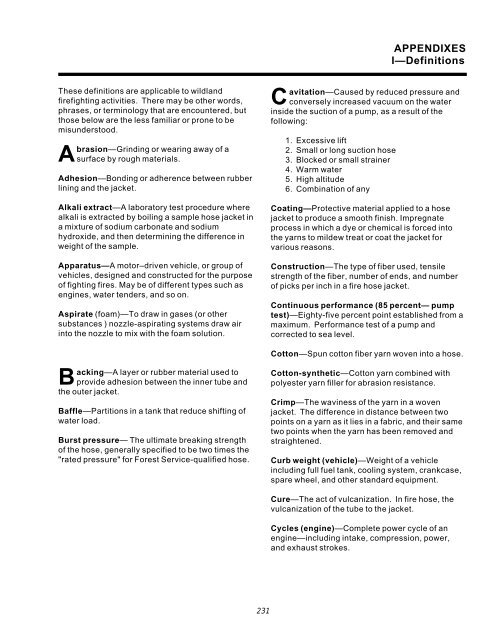Water Handling Equipment Guide - National Wildfire Coordinating ...
Water Handling Equipment Guide - National Wildfire Coordinating ...
Water Handling Equipment Guide - National Wildfire Coordinating ...
Create successful ePaper yourself
Turn your PDF publications into a flip-book with our unique Google optimized e-Paper software.
APPENDIXES<br />
I—Definitions<br />
These definitions are applicable to wildland<br />
firefighting activities. There may be other words,<br />
phrases, or terminology that are encountered, but<br />
those below are the less familiar or prone to be<br />
misunderstood.<br />
Abrasion—Grinding or wearing away of a<br />
surface by rough materials.<br />
Adhesion—Bonding or adherence between rubber<br />
lining and the jacket.<br />
Alkali extract—A laboratory test procedure where<br />
alkali is extracted by boiling a sample hose jacket in<br />
a mixture of sodium carbonate and sodium<br />
hydroxide, and then determining the difference in<br />
weight of the sample.<br />
Apparatus—A motor–driven vehicle, or group of<br />
vehicles, designed and constructed for the purpose<br />
of fighting fires. May be of different types such as<br />
engines, water tenders, and so on.<br />
Aspirate (foam)—To draw in gases (or other<br />
substances ) nozzle-aspirating systems draw air<br />
into the nozzle to mix with the foam solution.<br />
Backing—A layer or rubber material used to<br />
provide adhesion between the inner tube and<br />
the outer jacket.<br />
Baffle—Partitions in a tank that reduce shifting of<br />
water load.<br />
Burst pressure— The ultimate breaking strength<br />
of the hose, generally specified to be two times the<br />
"rated pressure" for Forest Service-qualified hose.<br />
Cavitation—Caused by reduced pressure and<br />
conversely increased vacuum on the water<br />
inside the suction of a pump, as a result of the<br />
following:<br />
1. Excessive lift<br />
2. Small or long suction hose<br />
3. Blocked or small strainer<br />
4. Warm water<br />
5. High altitude<br />
6. Combination of any<br />
Coating—Protective material applied to a hose<br />
jacket to produce a smooth finish. Impregnate<br />
process in which a dye or chemical is forced into<br />
the yarns to mildew treat or coat the jacket for<br />
various reasons.<br />
Construction—The type of fiber used, tensile<br />
strength of the fiber, number of ends, and number<br />
of picks per inch in a fire hose jacket.<br />
Continuous performance (85 percent— pump<br />
test)—Eighty-five percent point established from a<br />
maximum. Performance test of a pump and<br />
corrected to sea level.<br />
Cotton—Spun cotton fiber yarn woven into a hose.<br />
Cotton-synthetic—Cotton yarn combined with<br />
polyester yarn filler for abrasion resistance.<br />
Crimp—The waviness of the yarn in a woven<br />
jacket. The difference in distance between two<br />
points on a yarn as it lies in a fabric, and their same<br />
two points when the yarn has been removed and<br />
straightened.<br />
Curb weight (vehicle)—Weight of a vehicle<br />
including full fuel tank, cooling system, crankcase,<br />
spare wheel, and other standard equipment.<br />
Cure—The act of vulcanization. In fire hose, the<br />
vulcanization of the tube to the jacket.<br />
Cycles (engine)—Complete power cycle of an<br />
engine—including intake, compression, power,<br />
and exhaust strokes.<br />
231
















